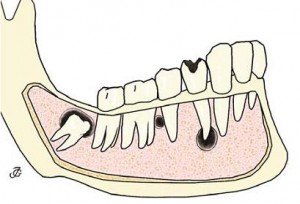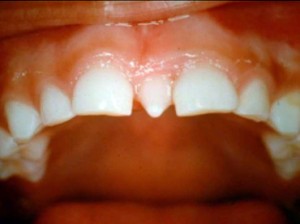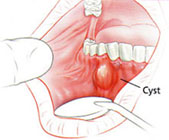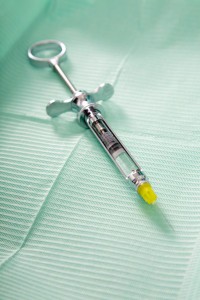Mucosal barrier has also been suggested as an etiologic factor in DTE. Any failure of the follicle of an erupting tooth to unite with the mucosa will entail a delay in the breakdown of the mucosa and constitute a barrier to emergence. Histologic studies have shown differences in the submucosa between normal tissues and tissues with a history of trauma or surgery. Gingival hyperplasia resulting from various causes (hormonal or hereditary causes, vitamin C deficiency, drugs such as phenytoin) might cause an abundance of dense connective tissue or acellular collagen that can be an impediment to tooth eruption. Continue reading
Cysts of the Jaw Part 1
Swellings and lumps in the mouth are common. Some may be just anatomical structures in the mouth while some may be of other origin, including jaw cysts. Continue reading
The Extra Tooth!
Did you ever wonder why do you find some children with a small extra tooth in between their permanent incisors?
This small little tooth is called Supernumerary Tooth.
Â
A Supernumerary Tooth is one that is additional to the normal series and can be found in almost any region of the dental arch. Most supernumerary teeth are located in the upper incisors region commonly known as mesiodens. Their presence may give rise to a variety of clinical problems in the future for children.
Delayed eruption of teeth Part 2
Primary or idiopathic failure of eruption is a condition described by Profitt and Vig, whereby nonankylosed teeth fail to erupt fully or partially because of malfunction of the eruption mechanism. This occurs even though there seems to be no barrier to eruption, and the phenomenon is considered to be due to a primary defect in the eruptive process. Terms such as arrested eruption and noneruption have been used interchangeably to describe a clinical condition that might have represented ankylosis, impaction, or idiopathic failure of eruption. These terms refer more to the pathogenesis of DTE than to the benchmarks that define DTE. Continue reading
How to Treat a Jaw Cyst
A cyst is defined as a pathological cavity having fluid or semi-fluid contents, which has not been created by the accumulation of pus. Cysts of the jaws are more common than in any other bone, and the majority are lined wholly or in part by epithelium. Continue reading
Delayed eruption of teeth Part 1
Eruption is the axial movement of a tooth from its nonfunctional position in the bone to functional occlusion. However, eruption is often used to indicate the moment of emergence of the tooth into the oral cavity. The normal eruption of deciduous and permanent teeth into the oral cavity occurs over a broad chronologic age range. Racial, ethnic, sexual, and individual factors can influence eruption and are usually considered in determining the standards of normal eruption. True and significant deviations from accepted norms of eruption time are often observed in clinical practice. Premature eruption has been noted, but delayed tooth eruption (DTE) is the most commonly encountered deviation from normal eruption time. Continue reading
Dry Socket and Its Management
 What is a dry socket?
What is a dry socket?
Dry socket or also known as alveolar osteitis is a common complication occurring after the extraction of a permanent teeth especially the lower wisdom teeth. The term ‘alveolar’ refers to the jawbone that supports teeth while ‘osteitis’ refers to the inflammation of the bone associated with the extraction socket.
The condition has generally been characterized by degraded or delayed healing associated with breakdown or dislodgement of the blood clot in the extraction socket. It is usually accompanied by persistent, radiating pain in and around the extraction site within a few days after extraction that is not easily relieved by pain killers. The premature loss or breakdown of the blood clot is accompanied by exposure of the underlying bone. Continue reading
Complications in Local Anesthesia
Inserting a foreign body into our body may bring risk of complications. The same goes for injecting local anesthetic agents or pain numbing solution into the mouth for a dental procedure. Complications in administrating dental anesthesia may occur due to preventable or unpreventable circumstances. Continue reading
Eruption dates
Human beings have two sets of teeth —- Primary (milk teeth) and Permanent. There are 20 primary and 32 permanent teeth. In some people one or more teeth may be absent, or they may have some extra teeth (supernumerary). Usually the first primary teeth erupt by 6 months and the first permanent by 6 years of age. Children loose their milk teeth between 6 and 11 years of age. By the age of 13 years almost all the permanent teeth have erupted: 8 incisors, 4 canines, 8 premolars and 12 molars. The last 4 molars commonly known as wisdom teeth appear much later, between 18 to 21 years. The main function of your teeth is to chew and cut food. Anterior teeth are used to bite and tear food while the posterior teeth help in chewing. Hence your dental health is an important part of your general health and your overall well-being. Continue reading
Hall technique Part 5
Important additional notes
1) The crowns used in the research presented here were Ni-Cro Primary Molar Crowns, cemented with AquaCem, both from
3M/ESPE. Any adjustment of the crowns was minimal, and was limited to re-molding the crown margins in some cases with orthodontic band forming pliers. No crown had the margin trimmed. Continue reading



